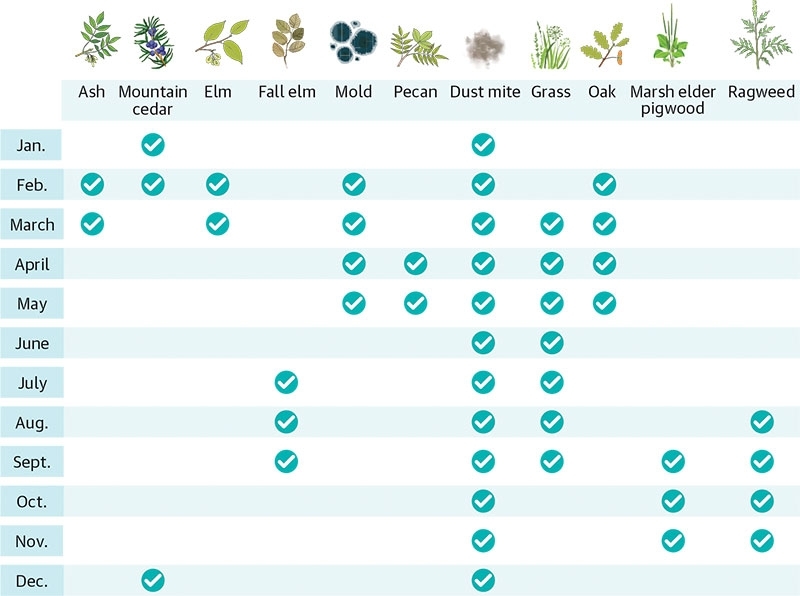Allergy symptoms
Those with allergies may experience symptoms similar to a cold or flu, according to the Asthma and Allergy Foundation. Some common symptoms related to allergies:
- Sneezing, runny nose or stuffy nose
- Cough
- Itchy eyes
- Fatigue
- Headache
- Sore throat
- Fever
- Aches and pains
- Shortness of breath
- Loss of taste or smell
The allergens in the area include grass, mold, ragweed, dust mites and trees, said Alexander Alvarez of Austin Regional Clinic. In spring, trees release pollen through June, and windy, dry conditions move the pollen in the air. In the winter, cedar fever is common.

Remedies for allergies
- Antihistamines (Zyrtec, Allegra, Claritin)—Relieve sneezing and itching in the nose and eyes while reducing a runny nose
- Decongestants (Sudafed, Vicks Sinex, Afrin)—Help relieve stuffiness/congestion
- Nasal corticosteroid sprays (Flonase, Nasacort, Rhinocort)—Reduce swelling in the nose and block allergic reactions
- Nasal rinses (Ayr, Neilmed or own recipe)—Clear sinuses, removing pollen and mucus
Allergies are caused by the body’s immune system overreacting to something foreign in the environment, such as pollen or mold. The cause of allergies is unknown, but there are predictions among specialists, said Alvarez.
Do allergies get worse
In some ways, yes. After being exposed to common allergens during one season, the next exposure may cause a reaction, said Alvarez.
What is “cedar fever”
Allergies in the Austin area from December through February are largely caused by the ashe juniper tree, more commonly known as the mountain cedar tree, according to Greater Austin Allergy. The term “cedar fever” refers to allergy symptoms including:
- Nasal congestion
- Sneezing
- Itchy eyes
- Sore throat
- Headache
- Fatigue
When to see a doctor
When over-the-counter remedies are not working or other allergic conditions including asthma or eczema are affecting someone, this is a good time to see a specialist. A specialist can also discover what someone is allergic to and provide additional remedies, said Alvarez.
People with certain allergies may seek immunotherapy—or the practice of exposing individuals to allergens slowly to build up a tolerance. These include:
- Allergy shots—given at the doctor's office
- Sublingual immunotherapy—drops placed under the tongue at home daily






